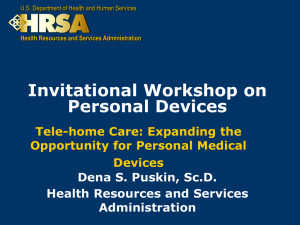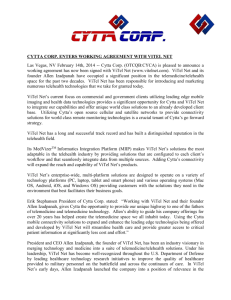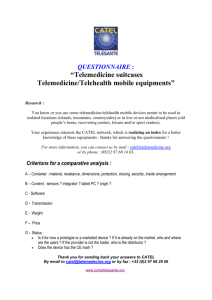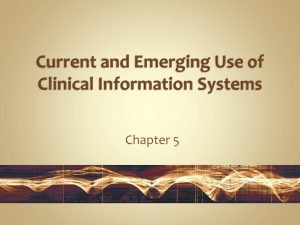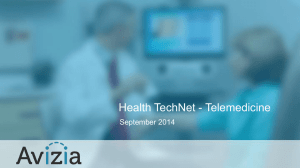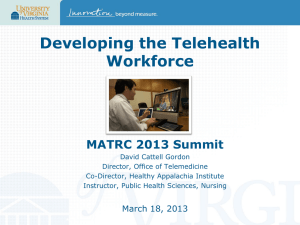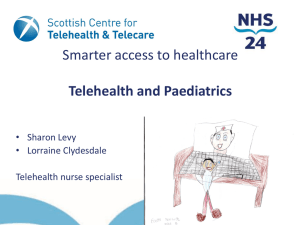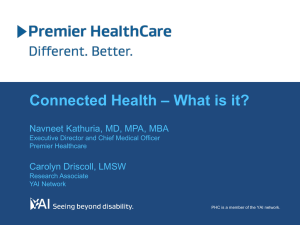Eating for Heart Health (E4H²): A Kiosk-Based Public
advertisement
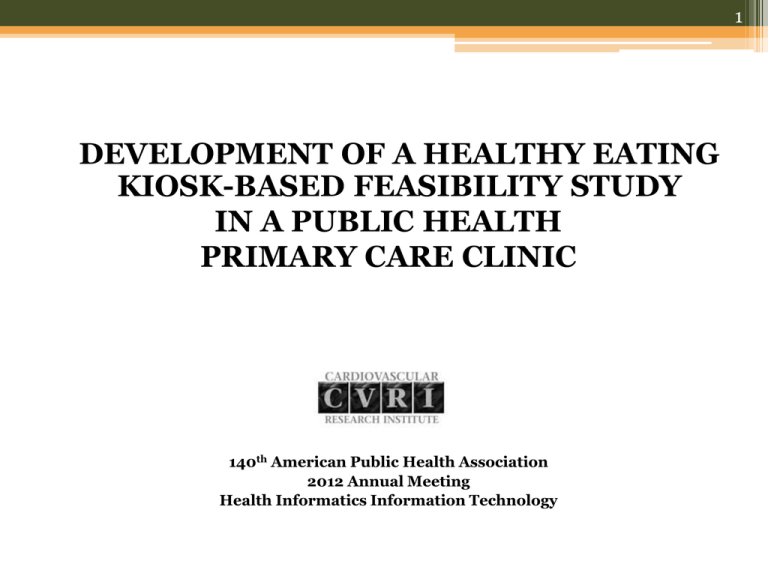
1 DEVELOPMENT OF A HEALTHY EATING KIOSK-BASED FEASIBILITY STUDY IN A PUBLIC HEALTH PRIMARY CARE CLINIC 140th American Public Health Association 2012 Annual Meeting Health Informatics Information Technology 2 WSU RESEARCH TEAM Julie Gleason-Comstock, PhD, MCHES, PI and Assistant Professor Department of Family Medicine & Public Health Sciences (DFMPHS) Wayne State University (WSU) Nancy T. Artinian, PhD, RN, FAHA, FPCNA, FAAN, Co-PI, Professor Associate Dean for Research, Director of Center for Health Research College of Nursing, WSU Catherine Jen, PhD, Co-PI, Professor Chair, Department of Nutrition and Food Science, WSU Alicia Streater, PhD, Co-PI, Research Associate Center for Urban Studies, WSU Presenters Disclosures “No relationships to disclose.” 3 RESEARCH MENTORED STUDENTS Suzanne Baker, PhD, DFMPHS, MPH Candidate Bosede Joshua, MBBS, MPH, DFMPHS Kristin Oneail, RN, MSN, Nursing PhD Candidate Deborah Slago, RN, MSN, Nursing PhD Candidate Jessica Timmins, Honors Nutrition & Biology Andy Paranjpe, MD/MPH 2011-2016 www.cvri.med.wayne.edu_trainees 4 RESEARCH PARTNERS PRIMARY CARE City of Detroit Department of Health & Wellness Promotion Herman Kiefer Adult Primary Care Clinic TELEHEALTH American TeleCare and LifeView www.americantelecare.com www.LifeviewTransform.com 5 LEARNING OBJECTIVES • Describe the development of a telehealth education study • Assess the feasibility of integration into a primary care clinic 6 CARDIOVASCULAR DISEASE PREVENTION AND HEART HEALTH Heart disease & stroke are 1st & 3rd leading causes death for men & women men (33.6% all U.S. deaths), yet among the most preventable • 2010 cost of CVD in U.S. estimated @ $444 billion; about $1 of every $6 spent on healthcare http://www.cdc.gov/chronicdisease (2012) 7 CVD DEATH RATES • Age-adjusted death rates for CVD are 37% higher among African-Americans than Whites • Risk of having a stroke is nearly 2x higher for African-Americans than Whites http://www.cdc.gov/chronicdisease (2012) 8 CVD PREVENTION SAVES LIVES • Healthy lifestyle, including healthy food choices, and a healthy weight reduce risk of developing heart disease/stroke • Preventing and controlling blood pressure also play a significant role in CVH http://www.cdc.gov/chronicdisease (2012) 9 CVD - USA CHALLENGE • Nearly 68 million adults have high blood pressure & about half do not have this condition under control • Estimated 71 million adults have high cholesterol & nearly 2/3 do not have this condition under control http://www.cdc.gov/chronicdisease (2012) CDC 2012. Vital signs awareness and treatment of uncontrolled hypertension among adults 2003-2010. MMWR 61(35) 703-709. Accessed Sept 7, 2012. 10 NATIONAL PREVENTION STRATEGY 2011 PLAN Clinical and Community Services Recommendations • Support National Quality Strategy’s focus on improving cardiovascular health. • Expand use of interoperable health information technology to improve preventive services, quality of care & reduce health care costs. • Support implementation of community-based preventive services & clinical linkages . • Reduce barriers to access clinical & community preventive services. • Enhance coordination & integration clinical & behavioral health, including telemedicine. National Prevention Council (June 2011). Clinical and Community Preventive Services. National Prevention Strategy. http://www.healthcare.gov/center/councils/nphpphc 11 RELEVANCE OF HEALTH REFORM TO HEALTH INFORMATION TECHNOLOGY Improvement of quality of healthcare by increasing quality data collection, creating new programs, and payment to existing entities for improvement. 1 1 Patient Protection & Affordable Care Act (PPACA, H.R. 3590): Summary of Key Health Information Technology Provisions, June 1, 2010 www.himss.org. Accessed January 26, 2012. 12 HEALTH REFORM AND TELEMEDICINE STRATEGY Response from American Telemedicine National Health Reform Timeline and Telemedicine Public Policy Papers (2011) ▫ Telemedicine should be one component of any national strategy to increase access, improve quality and lower the costs of healthcare. http://www.americantelemed.org 13 TELEMEDICINE AND TELEHEALTH • Telehealth is within the family of telemedicine electronic communication & information technology • It encompasses broader application, such as distance education & consumer outreach to support healthcare services. 1 1 American Telemedicine Association. (2006) Telemedicine, Telehealth and Health Information Technology: An ATA Issue Paper. http://www.americantelemed.org 14 TELEHEALTH TECHNOLOGY • Kiosks are one example of telehealth technology. • Computer-based systems designed to facilitate information access & exchange, enhance decision making , provide social and emotional support, & help behavior changes that promote health and well-being. 1 1 Or C, Karsh B-T (2009). A systematic review of patient acceptance of consumer health information technology. J of the Amer Informatics Association 16 (4): 550-556. doi:10.1197/jamia.M2888 15 UTILIZATION • Potential for using consumer health technology to improve health has been acknowledged, but technologies are not always accepted by patients. • Reasons can include device usability, computer skills and low self-efficacy. • Evidence shows substantial numbers of potential users, including those underserved by the health system, do not accept consumer health information technology. 1 1 Jimison H, Gorman P, Woods S, et a . Barriers and drivers of health information technology use for the elderly , chronically ill, and underserved(2008) Evid Rep/Technol Assess 175. AHRQ Publication No. 09-E004. Rockville, MD: AHRQ. 16 RESEARCH POTENTIAL Health information technology studies are needed that examine variables predicting consumer acceptance, including identifying factors which: ▫ Create acceptance for the technology ▫ Develop & evaluate the ability of applications to fulfill consumer expectations ▫ Increase the likelihood of technology implementation success. 1 Literature review related specifically to health kiosks identified a role for integrated kiosks as part of patient flow, e.g., physical monitoring or planned education. 2 1 2 Jamison et al, (2008), Barriers of HIT for elderly, chronically ill & underserved, AHRQ. Jones R. (2009) The role of health kiosks in 2009: literature and informant review. Int J Environ Res Public Health 6: 1818-1855. doi.10.3390/ijerph6061919 17 Eating for Heart Health (E4H2): A Kiosk-Based Public Health Education and Primary Care Feasibility Study Cardiovascular Research Institute Isis Award Department Family Medicine & Public Health Sciences School of Medicine, Wayne State University 2010 – 2011 18 HEALTH INFORMATION TECHNOLOGY: AMERICAN TELECARE, INC. Telehealth company with affordable kiosk technology, experience in evidence-based chronic disease management & patient education. ▫ Web-based orientation & training for multi-user station and peripherals ▫ Real-time operational support 19 TECHNOLOGY • Telehealth provider station with administrator log-in to secure website. • Kiosk multi-user station for multiple encounters with: ▫ ▫ ▫ ▫ Interactive touch screen including audio option Password protected log-in Self-monitoring for weight/blood pressure Health education modules 20 RESEARCH DESIGN • Convenience sample 51 adults with BMI > 25 • Participant kiosk log-in over six weeks • Randomized into two groups of six sessions ▫ Nutrition/Intervention (25 participants) Primarily diabetes education content Weight self-monitored via kiosk ▫ General Health /Attention Control (26 participants) Hypertension, physical activity, smoking & stress education content Blood pressure self-monitored via kiosk 21 IMPLEMENTATION • Baseline and follow-up blood pressure & weight assessments conducted by graduate nurses • Demographic, healthy eating behaviors and satisfaction surveys conducted by nutrition and public health students • Research faculty & students from public health, nursing and nutrition faculty cross-trained in cardiovascular health & telehealth technology 22 RESEARCH PROTOCOL APPROVAL • The research protocol was approved by the Wayne State University Institutional Review Board (IRB) and the City of Detroit Health Department Research Committee. 23 PARTICIPANT SCREENING/BASELINE Body Mass Index 25-29 (Overweight) 30-39 (Obese) 40-54 (Extreme Obesity) 35% 18% 47% 24 PARTICIPANTS Average age about 50 years old, primarily AfricanAmerican and female. About equally divided between education of high school/less, or some trade school/college. About half had annual household income of $10K or less; half between $10K - $35K. Around three-quarters had used the internet in the past six months, and two-thirds of those at home. 25 CLINIC VISITS • Clinic Visit Frequency ▫ ▫ ▫ ▫ Every 2-3 months (49%) Monthly (18%) New to clinic (14%) Other (19%) • Waiting Time ▫ ▫ ▫ ▫ 1-2 hours (41%) <1 hour (33%) 3 or more hours (12%) Other (12%) 26 KIOSK FEASIBILITY STUDY DEVELOPMENT • Kiosk-based consumer health information technology was feasible in a primary care environment. • Telehealth corporate - academic partnership resulted in a health education pilot with an underserved population. 27 PRIMARY CARE CLINIC INTEGRATION ▫ Short, flexible kiosk sessions did not interrupt patient visits ▫ Participants returned for multiple kiosk sessions 28 FUTURE STUDY DIRECTIONS • Expand from primary care clinic to health systems environment • Develop Community Health Worker/Peer Educator CBPR training curriculum • Integrate consumer health information technology into multiple kiosk/interactive website/tablet/smart phone 29 E4H² TeleHealth Feasibility Study SCREENING INTERVENTION FOLLOW UP OUTCOMES 6 Sessions Nutrition Modules Weight Blood Pressure Weight What Are You Eating Pre-Test BMI>25 Kiosk Sessions General Health Modules Blood Pressure 3 MONTHS Post Test (2 months) Baseline Survey EATING BEHAVIORS What You Eat Weight MyPlate.gov Blood Pressure
